This guy summed it up rather nicely i think.Oh, man, this has to be the only Civil War TL I absolutely love. Also possibly the best military alternate history I've ever read, what with being able to follow the movements of all armies on the maps you provide. Amazing.
You are using an out of date browser. It may not display this or other websites correctly.
You should upgrade or use an alternative browser.
You should upgrade or use an alternative browser.
A Glorious Union or America: the New Sparta
- Thread starter TheKnightIrish
- Start date
Threadmarks
View all 207 threadmarks
Reader mode
Reader mode
Recent threadmarks
Chapter One Hundred and Fifty Nine The Long Road Home Chapter One Hundred and Sixty A New Beginning Part I Chapter One Hundred and Sixty One A New Beginning Part II Chapter One Hundred and Sixty Two A New Beginning Part III Chapter One Hundred and Sixty Three The Emperor is Enthroned Chapter One Hundred and Sixty Four The Emperor's Coat-tails Part One Chapter One Hundred and Sixty Five The Emperor's Coat-tails Part Two Chapter One Hundred and Sixty Six The Consuls of His EmpireThis guy summed it up rather nicely i think.
Yeah, though I just remembered a TL I liked just as much about the Civil War. Sadly defunct now, though.
what is it? Link, if you have one.Yeah, though I just remembered a TL I liked just as much about the Civil War. Sadly defunct now, though.
Took a bit of searching (couldn't remember the author or the TL), but here it is: DirtyCommie's One Nation Indivisible. It only had a few updates and the writing is meh, but the idea has to be one of the best I've seen in a while.
Chapter Thirteen Duck! The Battle of Duck River Part III
Chapter Thirteen
Duck! The Battle of Duck River
Part III
Duck! The Battle of Duck River
Part III
From “The Battle of Shelbyville” by Jones N. Keegan
Osprey 1998
“Crittenden’s orders to Van Cleve may have been responsible for his lack luster performance that day. He was ordered to “make a demonstration before the left wing of the Rebel line. Your attack is to be made and maintained until Thomas can make a lodgment on our left”. Van Cleve seems to have focused on the word demonstration rather than the word attack. Thus, despite having been provided with an adequate pontoon train, he did not aggressively pursue his attack or meaningfully attempt to cross Duck River. Indeed Van Cleve found it “difficult to concentrate on developing the crossing and assault to our front for the balls General Wheeler threw at our headquarters from our right flank. It was very good shooting for horse artillery I am told.” (Captain Lawrence G. Buckman)…
John Palmer’s performance was quite the reverse. He only read the word “attack”. ..Twenty minutes after firing commenced on Van Cleve’s front, the engineers assigned to Palmer were attempting to restore a crossing at what was formerly the Shelbyville Bridge. McCown’s small arms fire was not enough to stop the completion of a viable crossing by mid-morning…McCown missed the presence of divisional artillery that morning, and his request for support went unanswered…
Palmer’s leading troops sustained terrible casualties in the initial assault on McCown’s position…Ultimately Palmer’s troops secured a lodgment on the Rebel bank of the river forcing McCown’s right flank back down the Fayetteville Pike to the line of the Big Flat Creek…Crittenden sought to support this success with troops from Davis division, but as the lodgment was a narrow one, Palmer had not yet been able to cross with his full division…
Van Cleve’s lassitude allowed McCown to continually to reinforce his right flank. At the critical moment General Cleburne led Liddell’s Brigade into the exposed left of Palmer’s lodgment. Palmer’s attack collapsed under this counterattack…
Cleburne leads Liddell's Brigade to the attack
Palmer would attempt several times more during the afternoon to development a lodgment. His divisions performance and willingness to try that day was second to no other division in the Union Army. Its casualties were correspondingly high…”
From “The Battle of Duck River” by C. M. Townsend
LSU
“Poor communication between Crittenden, McCook and Johnson meant that Scullcamp Ford went unattended by Union forces that day. Johnson’s division instead attacked Caldwell’s Ford, while Mitchell assaulted Lacey’s Ford. Both attacks were in full view of Robertson’s “Grand Battery”. Mitchell in particular suffered from assaulting “infantry and artillery on a very narrow front, heavily fortified, while exposed completely on the flank to a storm of shot and shell” (General Robert B. Mitchell)…
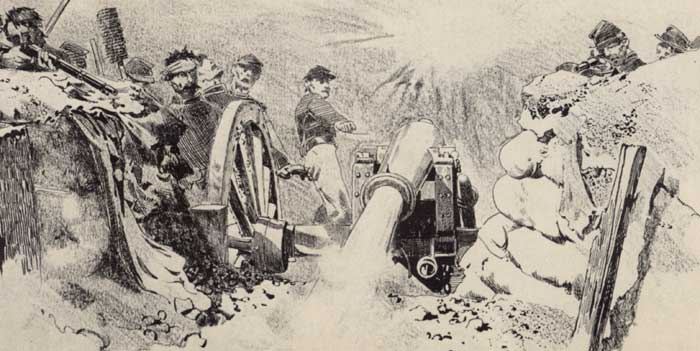
“Like logs in a flood in our old river at home, the bodies of Yankees all but damned the river” (Color Sergeant J.S. Green)…
The position of Churchill’s line allowed Johnson to feed half a brigade into the open ground in the loop of the river. “The Bloody Bend” may sound like hyperbole, but it was an appropriate name. Churchill had created a killing ground into which Johnston fed his troops. “I lay up to my neck in the water, flat against the bank. To take a step further onto the bank, was to resolve to met the creator…” (Major Joab P. Stafford)…
Rosecrans was not perturbed. Generals Palmer and Johnston had “forced” lodgments on the Rebel bank. He surmised Hardee must be re-enforcing his left. It was after 1.30pm that Thomas’ attack was unleashed on the Confederate right…
Chapter Thirteen Duck! The Battle of Duck River Part IV
Chapter Thirteen
Duck! The Battle of Duck River
Part IV
From “The Battle of Shelbyville” by Jones N. Keegan
Osprey 1998
Osprey 1998
“James Jackson’s attack went in at Three Forks Mill Ford. The mill itself was built on a slight eminence and so Jackson was able to get a couple of batteries into position to pepper Cheatham’s line with shot. Under the cover of this barrage Colonel Walker’s Brigade went in. The Ohioans, with a handful of Indianans, stormed across the ford with alacrity. Cheatham’s forward line, which was effectively only a skirmish line, quickly fell back. It was then that Walker’s men ran into the Cobb Farm complex, that was known to the Rebels as Fort Creighton. Without artillery Walker could not make any breaches in its, all be it rudimentary, defences. Fort Creighton was to be an uncrackable nut for Jackson’s Division until artillery could be brought across the ford…

Thomas' Batteries at Sulphur Bluff
Negley’s attack, against Paines and Good Fords, too seemed to falter. Wither’s defensive line in this sector was right on the riverside, in dug in positions. However as the afternoon progressed, Wither’s casualties mounted, not as the result of Negley’s attempts to cross, but as a result of Thomas’ artillery which had been ranged on Sulphur Bluff, exactly as Withers had feared. Nonetheless his lines were holding…
General Rousseau was becoming agitated. There seemed little prospect of his division coming into action in support of either Jackson or Negley. The fords were simply too narrow and too well defended. He therefore left a surprised Col. John C Starkweather in charge of the division while he personally reconnoitred the river beyond Negley’s left. It was on this reconnaissance that he discovered the Deep Ford. It took perhaps 40 minutes to get his first brigade into position, but its attack on Wither’s right flank was devastating – Wither’s had stripped Col. Maingault of two regiments to reinforce his defence against Negley’s attack. Starkweather, whose brigade led the attack, quickly rolled by Wither’s line. Polk’s attempts to blunt the assault with an attack by Wharton’s dismounted cavalry was a nuisance that Rousseau seemed happy to ignore. Polk’s attempts to remedy the breach were curtailed by a shell from the Sulphur Bluff batteries, which took his left leg off below the knee. Wharton’s cavalrymen quickly rushed Polk from the field…The Rebel right had been beheaded at its most critical moment…
Rousseau realised he had secured the planned breakthrough and was quick to send messages to Negley to redouble his attack as Withers faltered, and to Thomas to reinforce both attacks. Thomas seized the moment, and the division of General Philip Sheridan, which was unemployed in the rear of McCook’s attacks. Furthermore Rosecrans was quick to detach Jeff Davis’ Division on his right and send it marching to support Thomas. Thomas might soon have control of 5 Union divisions to bring against the Rebels collapsing right wing…”
From “The Battle of Duck River” by C. M. Townsend
LSU
LSU
“As the Federals pushed Withers back through Rowesville, he had the good sense to send a galloper to Cheatham to warn him of the breakthrough. Cheatham would quickly be in serious difficult as Withers withdrew. In his current position he risked having Thomas attack his open right flank. Such an attack, while still fending off Jackson’s assaults on Fort Creighton, could roll up his line.
In the absence of Polk, Cheatham took the risky decision of abandoning the line of the river. Leaving the garrison of the farm to slow the pursuing Federals in his rear, he would retreat towards his reserves on the line of Tompson’s Creek. He advised Withers to maintain contact with his troops and retreat along the Kunze Farm and Jenkins Farm tracks to the creek. Hardee’s rides along the south bank with his generals were paying dividends in the midst of this crisis…
The fall of Cobb's Farm
It was Robertson from his barn top vantage point who first spotted the breakthrough, quickly alerting Hardee and Breckinridge who were together on the high ground near Davidson’s farm. A message sent by Cheatham quickly followed. “The enemy has forced a lodgement and is advancing in large numbers, at least two divisions. Withers is falling back on my flank. Intend to retire to the line of Tompson’s Creek. Request assistance and artillery upmost…”...
Hardee’s first action was to order McNair’s Brigade to the support of Cheatham. He then authorised the redeployment of two of Robertson’s batteries, but their removal from the fortified heights would take time. Hardee’s concern increased as all on the heights observed Federal troops marching east (the divisions of Sheridan and Davis)…
It was then that a messenger from Wharton brought news explaining the silence of General Polk on the right. Hardee resolved to take more decisive action. He summoned Generals Churchill and Cleburne to join him on the ridge. It was approaching 3pm…
Could General Churchill hold his current position as well as spare troops to cover the Scullcamp Ford? Churchill confirmed he could. He still had a full brigade in reserve. Could General Cleburne redeploy his division quickly to the right? Cleburne confirmed that he could. Only one of his brigades, Liddell's, had seen any fighting that morning and their success had only given them “more of a spirit to fight”. The rest of his brigades were fresh and ready to move. They could use the dirt road running parallel to river all the way to Tompson’s Creek. General McCown’s front had stabilised and he could hold his own against Palmer, Cleburne felt…
So Hardee left Breckinridge on the left to manage McCown, Churchill and Wheeler, and rode with Cleburne and his division to the relief of the right…”
From “The Irish Corporal – The Life and Battles of Patrick Ronayne Cleburne” by James Fitzgerald Maguire
Trinity Press
Trinity Press
“Thomas had crossed the river in person and had organised the deployment of Rousseau and Negley. Negley advanced over a front from Paines Ford, through Rowesville, half way to the Kunze farmhouse, Rousseau formed his troops on Negley’s left fanning out to the south. It was about this time that Jackson’s men manhandled some artillery across Three Forks Mill Ford and pounded the Cobb Farmhouse. The remains of that command surrendered, under Lieutenant Creighton, about 4.30pm. Having removed the main obstacle to his advance Jackson pressed on with the intention of linking up with Negley’s right as he advanced…
Cleburne arrived with the leading brigade of his division near the Jules Farm. As one soldier observed “Look at General Cleburne, don’t you see war in his eyes?”. Cleburne quickly deployed his division into line, keeping Liddell in reserve, between Cheatham and Withers hastily formed line along the creek. Hardee had already inspected the position. “Tell Cleburne we are to fight,” Hardee said to a staff officer and “that his division will undoubtedly be heavily attacked, and that he must do his best”…
Col. John Beatty of Rousseau’s Division observed “with the exception of the narrow dirt tracks running directly to the rebel lines, the intervening ground was some of the roughest broken ground it has ever been my misfortune to fight over”. Rousseau’s attack on Withers and on Cleburne’s right was, as a result of the broken nature of the ground, piecemeal and disorganised. The ground was easier to Negley’s front. Negley launched his three brigades at Cleburne’s line, to be repulsed. A second attacked was launched, with Brigadier General Sill’s Brigade of Sheridan’s Division in support…
"Time after time, line after line of Federals charged over that ground against Cleburne’s lines,” a soldier of Cheatham’s Division observed “only to be shattered and hurled back into the hollows”…
The light of the day was fading. Rousseau’s and Negley’s Divisions were exhausted and only one brigade of Sheridan’s troops had arrived as he had been ordered to cross by the Deep Ford. Cleburne resolved on a bold move. If Cheatham could cover his flank to prevent flanking fire from Jackson, Cleburne would lead the brigades of McNair, Polk, Johnson and Liddell, once again, in an attack. (Wood faced off against Rousseau and Withers requested he remain on his flank). Hardee approved the move...The last things Negley’s Federals expected was a counterattack…
“We all believed Cleburne, that the success of this counterattack would compel the Federals to give up their assault altogether” General St.John R. Liddell…

Negley's troops flee in the face of Cleburne's counterattack
Sweeping in an arc, with its hinge on the Jules farm, Cleburne’s brigades attacked. Negley’s forces did not stand. Some made for Paines Ford; some held up in Rowesville; some made for Rousseau’s line. Sheridan, however, personally steadied Sill’s brigade and withdrew in fine order towards the railroad, Deep Ford, and the brigade of Col. Roberts just crossing. Feeling the ground unfit for an attack and with night descending, Rousseau drew off with Thomas’ reluctant approval towards the railroad and the village of Normandy…
Jackson’s troops drew back to the farmhouse which had been the focus of their endeavours all day…
From “The Battle of Duck River” by C. M. Townsend
LSU
“Cleburne’s was not the last counterattack. Churchill saw an opportunity to raise a little hell on the left. With the Federals having missed Scullcamp Ford, within sight of the town, Churchill proposed to his corps commander that he lead two regiments across the ford. He would attack the town and Palmer’s flank. Having “raised a commotion” he would withdraw across the ford. Breckinridge was concerned this “diversion” would naturally highlight to the Federals the existence of the ford. Churchill suggested that, under the cover of night, this might not be so, but that in any event if the Federals made any efforts to question the remaining inhabitants of Shelbyville, they could expect to know about the ford soon enough. Breckinridge authorised the attack and Churchill personally led the 3rd and 9th Georgia Battalions across the river as soon as night fell…
Churchill led in person as the attack would require fine judgment in keeping the men in hand and in withdrawing in good time, safely across the river... “With fires in the town, many thought we were under a serious counterattack by at least a brigade. We did not known if the rebels had forced our pontoons at Shelbyville, which I thought unlikely, or crossed at some unknown point. Rosecrans arrived with his staff in great alarm, the burning buildings making a great spectacle on the horizon. It was an impressive shambles.”(Col. William B. Hazen)…
Churchill withdrew safely across the ford with only a handful of casualties. The diversion was to have an impact out of all proportion to the numbers involved…
Last edited:
Chapter Thirteen Duck! The Battle of Duck River Part V
Chapter Thirteen
Duck! The Battle of Duck River
Part V
From “The Battle of Shelbyville” by Jones N. Keegan
Osprey 1998
Osprey 1998
“General Thomas cussed Rosecrans up and down” one nearby soldier claimed upon receipt of the order to retire to the north bank. It was about 11pm…
The arguments have raged about whether the collapse of Negley’s Division was a reasonable justification for the withdrawal order. Sheridan’s Division was now on the south bank in force, and Davis’ Division was fresh and nearby on the north bank. Thomas’ position was therefore not as exposed as perhaps Rosecrans feared. Rousseau’s withdrawal to Normandy had secured his left flank…
On the other hand the conflagration in Shelbyville had spread a sense of panic among Palmer’s Division. Rosecrans was disconcerted by the perceived aggressiveness of the Rebels on both flanks. Clearly Hardee was present with the full force of the Army of Tennessee, and not divided as Rosecrans had expected…
“Only Thomas had made proper use of his corps artillery” Rosecrans observed in his report, while “the Rebel deployment of artillery, massed in his centre, was unprecedented, effective, and would have had a devastating effect on any renewed attack on the centre”…

Major General William Starke Rosecrans
From “The Battle of Duck River” by C. M. Townsend
LSU
“Hardee was surprised to see that the Federals had vacated the south bank on his right in the morning. Knowing General Thomas from the old army, he knew who was responsible “Thomas must be in a rage with Rosecrans. It is a poor judgment for which I am very grateful”. Hardee also knew who to credit his success to “General Cleburne’s support of McCown on the left and Cheatham on the right was in the highest traditions of our service, and was responsible for the near collapse of the Federal left… General Churchill’s night time raid on Shelbyville was well conceived and equally well executed. Its results were out of all proportion to the numbers of our troops involved…”.
Rosecrans roundly blamed Halleck. “I was forced to attack the enemy before I had achieved a full concentration [we assume he means that Nelson’s troops had not yet been formally assigned to him], with an inadequate number of cavalry and poor knowledge of the ground. The administration must bear the full blame for this setback…”. Perhaps an unsurprising response from a man who had first seen service in this war under the command of George B. McClellan…”
From “Army of the Heartland” by Col. J.T. Starke
University of Tennessee
“The Battle of Shelbyville did not end the fighting in Tennessee that spring. It was only the beginning. The next 40 days would see Rosecrans manoeuvre, first to the east, where McCook would clash with Cheatham’s Corps at Manchester, and Wheeler’s cavalry clashed with Stanley’s at Altamont and McMinnsville, and then in a race to the west.
The Second Battle of Shelbyville would see Churchill blunt an attempt to cross at the town by Sheridan’s Division. Forrest’s cavalry would then make an appearance in Rosecrans rear with a major skirmish at Chapel Hill. Skirmishes occurred up and down the Duck River as Rosecrans sought an opening to cross. but was skilfully blocked by Hardee, and the judicious use of his cavalry. Finally an opportunity in early March to catch Hardee was lost when Cleburne’s own “foot cavalry” beat Crittenden’s troops to the crossing at Columbia. In the ensuing attempt to force a crossing, Cleburne gave Van Cleve and Palmer’s Divisions a very bloody nose…
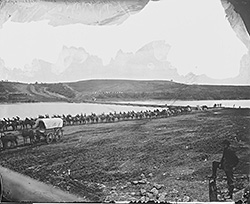
Union troops try to out pace Hardee's Army
Rosecrans withdrew to the vicinity of Spring Hill to rest and regroup. William Nelson’s Corps, at the time of only two divisions, was finally assigned officially to the Army of the Cumberland. It was designated XXIII Corps…
From “The War Between the States” by Otis R. Mayhew
Sword & Musket 1992
Sword & Musket 1992
“Congress was extremely displeased with the stagnant nature of the Tennessee front. Senator Sumner believed Hardee’s army should have been “driven into the Deep South to die by now! This bundling is intolerable”...Matters might have gone against Rosecrans if attentions were not focused on Virginia that spring...
General Bragg however believed Hardee could do more. “The movements of Rosecrans’ forces may present an opportunity for a descent on Nashville…You should not be content with holding Rosecrans to the river…Find a means to attack him with advantage…”. In the words of General Churchill “such ungratefulness will do little to endear Bragg to the boys of this fine army”. However attack was not far from Hardee’s mind…
Last edited:
Coming soon - Springtime in Virginia - Kearny & Butler v Lee.
I can't wait. Lee can't hold Richmond and Petersburg from Kearny and Butler. If Butler has got most of the Dept of North Carolina and the South troops with him in Suffolk, does that mean Lee will have bucket loads of reinforcements from the Carolinas, Georgia, and Florida? Good luck getting info on the Confederate forces on the coast in early 1863 - I can't find any.
I have also realised that without Antietam & Fredericksburg the Armies of the Potomac and Northern Virginia are likely a lot bigger than they were in OTL at this point...
Another interesting numbers question I have is, with Hardee occupying a larger area of Tennessee I wonder what that is doing for recruitment/conscription?
Chapter Fourteen The Butler's Tale
Chapter Fourteen
The Butler's Tale
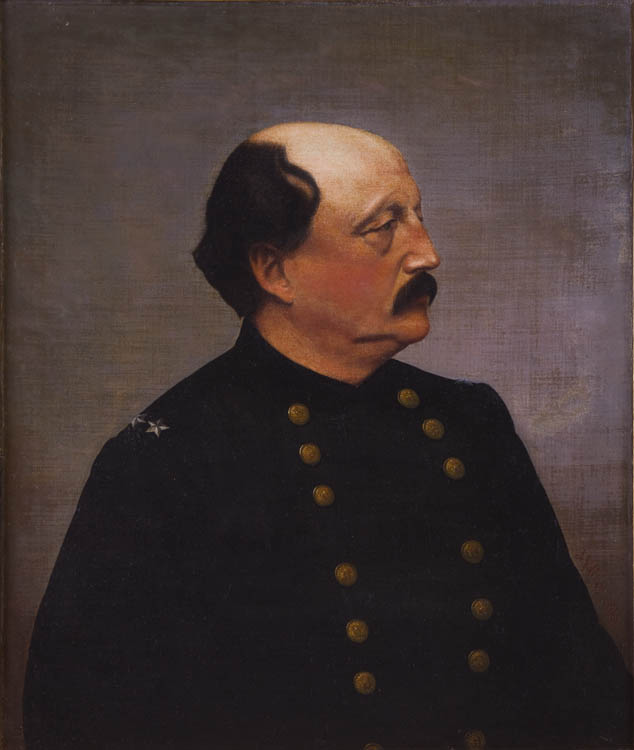
Major General Benjamin Butler
Commander of the Army of the James
From “The Fighting Lambs – The Army of the James” by Geoffrey T. W. Werner
Radical Press 1928
“By the middle of March Benjamin Butler had gathered his host around Suffolk, Virginia. XVIII Corps, under Ambrose E. Burnside, was the largest in the Union Army. Formally under David Hunter it had done sterling work in freeing the enslaved in South Carolina, Georgia and in Florida. Burnside had reorganised this force into 5 divisions under John G. Foster, Innis N. Palmer, Henry M. Naglee, Alfred H. Terry and George H. Gordon. Few troops were left behind in the south, unfortunately, but those left continued their good work under Robert H. Milroy, who would prove himself a righteous man in that role…



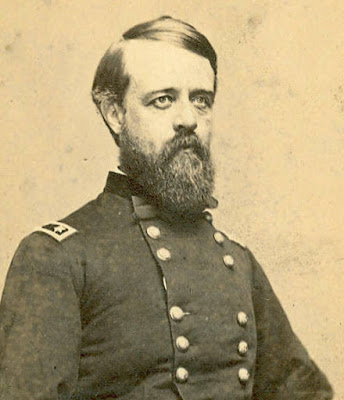
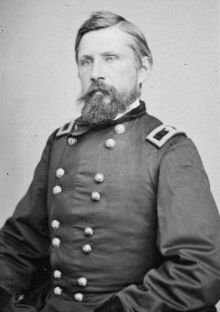
Generals Foster, Palmer, Naglee, Terry and Gordon
VII Corps numbered but three divisions, under Irvin McDowell, which had formerly been split between Norfolk, on the peninsula, and Suffolk. These three divisions were commanded by John J. Peck, friend of Kearny, Michael Corcoran, the noted Irishman, and George W. Getty, a southerner by birth. McDowell had left a small divisional sized force on the peninsula under the foreigner, Egbert Ludovicus Viele [sic – the general was a New York born]…
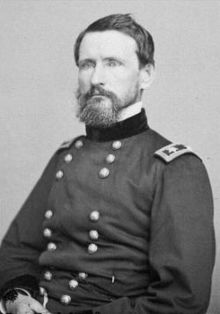


Generals Peck, Corcoran and Getty
The re-organisation over the winter had left two senior generals unassigned. Both volunteered to assist General Butler. General David Hunter held an unspecified position on General Butler’s staff, but it was generally held he would be appointed to a post appropriate to his stature as soon as one became available… The creation of a third corps from Burnside’s was muted. General Quincy A. Gilmore had also lost his post in the reorganisation but he had been recommended to Butler as the “best artillerist in the army”. Butler asked him to serve as the Army’s Chief of Artillery, if only until a better post could be found, and Gillmore consented…

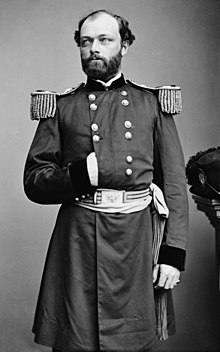
Generals Hunter and Gillmore
The War Office had assigned General Butler the task of taking Petersburg, and thus the severing of the major southern rail and road links between Richmond and the south. With the Rebel forces under General Lee fully occupied by Kearny, Butler anticipated this would be a relatively easy task…
XVIII Corps would advance along the line of the Norfolk & Petersburg Railroad, while the VII Corps would advance along the coastal roads via Newport Mews and Surry Courthouse, with the support of the navy…
It was beyond the Blackwater that the aspirations for General Butler’s command would meet their betrayal…”
Last edited:
Chapter Fifteen Too Clever By Half
Chapter Fifteen
Too Clever By Half
From “Kearny the Magnificent” by Roger Galton
NorthWestern
NorthWestern
“The winter had allowed Kearny to complete the reorganisation of the Army of the Potomac. The performance of Erasmus Keyes, at the head of IV Corps had been lacklustre. The performance of William Franklin, at the head of VI Corps, had been infuriating. As a result Keyes was replaced at the head of IV Corps by Darius N. Couch. Kearny also took William F. Smith from IV Corps and placed him at the head of VI Corps. As part of the re-organisation, the III Division of IV Corps was detached and assigned to the Department of the Shenandoah…


Generals Couch and "Baldy" Smith
Robert Milroy was transferred from his divisional command in XI Corps to command the much reduced Department of the South. He was replaced by Charles Devens…
Kearny had no intention of going into the campaign “with one boot off” so John F. Reynolds' three month tenure as head of the Department of the Shenandoah ended and he returned to command the I Corps, which also returned to the Army. Reynolds returned to join what some referred to as “Kearny’s holy trinity – Hooker, Reynolds and Sedgwick” (orginally attributed to William Seward)…
From “Yankee Dawdle - the Memoirs of a Private of Pennsylvania” by Anonymous
“Although we welcomed back our old general R to our campfires, we knew his return meant a spring of hard marchin [sic] and a summer of bloody mayhem. Huzzah for Old General R we cried!”
From “A Thunderbolt on the Battlefield – the Battles of Philip Kearny: Volume III” by Professor Kearny Bowes
MacArthur University Press 1962
MacArthur University Press 1962
“In February, the patrols of Buford and Pleasanton had fixed the location of Longstreet’s Headquarters at Trevilian Station, his divisions spread out covering the gaps from Rapidan in the north to the minor Hardware Gap in the south. Jackson was supposed to be based at Canton. His divisions were all south of the James River. The location of the bulk of Stuart’s horsemen was a matter of debate. Davis seemed convinced that Stuart was screening Richmond to the north, before Sedgwick and Reno on the Rappahannock, but Buford had expressed a concern. Something was stirring on the right beyond Jackson’s troops, it might be Stuart…
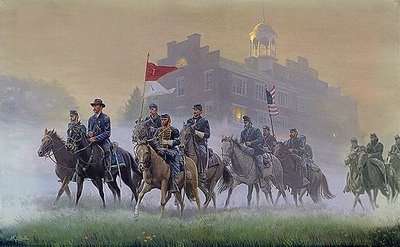
Buford leads his division on a patrol beyond Lynchburg
Phil Kearny had got the better of Robert E. Lee in the previous campaign, but Kearny did not expect Lee to calmly await his advance come the spring. “Lee cannot afford to stand on the defensive. A siege will kill his army and will finish the rebellion. He will go on the offensive if he can. We must, all of us, be alert to any movement by the enemy which could indicate an attack” Kearny warned his corps commanders…
An attack by Jackson on the extreme southern flank of the Army of the Potomac was not out of the question. The Army was still disbursed, covering the gaps and passes, and Mansfield’s XII Corps on the extreme right was spread thin, with detachments as far south as Rose Mills to support Buford, who had wintered his division at New Glasgow…
As a result the corps were ordered to concentrate. Kearny planned to march on 25 March, 4 days after Butler, in order that Butler's advance might draw off some of Lee’s forces. However on 22 March the Rebels, who until then had been happy to watch the routes through the hills from afar, advanced closely and in force to cover the likely routes of Kearny’s advance…
From Richardson at Rapidan to Mansfield in the south, all corps commander’s reported the gaps, passes and roads being closely covered, usually in brigade strength, by Rebel troops. Buford reported categorically that the bulk of Stuart’s cavalry was in the south covering the crossings over the James at Norwood and near Lynchburg…

"Fighting Joe" was given command of Kearny's left wing
From “Kearny the Magnificent” by Roger Galton
NorthWestern
Instead of the general advance he had planned, Kearny altered his orders. “Hooker’s” wing would led off; Richardson would push out of Rapidan and Hooker’s own corps would push the opposing Rebels beyond Orange Court House. All being well this movement would be followed by the two division of IV Corps, now under Couch, probing Gordonsville with support from Pleasanton’s cavalry. If Lee had moved his weight south, Hooker should push out quickly, with little resistance. Kearny would then risk ordering Sedgwick and Reno across to the south side of the Rapidan & Rappahannock Rivers…
This movement would be followed by VI and XI Corps, under Kearny’s own eye, crossing beyond Charlottesville. Finally a decision would be made about whether to move “Reynolds’” wing of I and XII Corps, along with Buford’s cavalry…
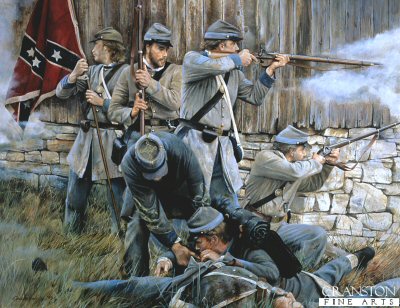
Confederate Skirmishers
Every corps commander had the same orders. To keep plenty of gallopers on staff to communicate with Kearny. To only engage brigade sized opposition. If larger formations were met these were to be reported immediately and the corps commander was to “dig in” pending further orders and support…Kearny’s corps were spread out over a large area and each corps could only be guaranteed the immediate support of one or two others, until the army concentrated somewhere north west of Richmond... But just as the hills screened Lee from Kearny’s eyes so to did it keep Lee from guessing where Kearny’s strength was, and where the blow would fall…
From “The Fighting Lambs – The Army of the James” by Geoffrey T. W. Werner
Radical Press 1928
Radical Press 1928
“Kearny’s strength was dissipated. It would take time for him to deal with the Rebels before him. His staged advance meant it was several days before he realised the makeup of the formations before him. Even then it took another two days to effect a concentration. Kearny’s failures were to have a catastrophic effect…
From “A Thunderbolt on the Battlefield – the Battles of Philip Kearny: Volume III” by Professor Kearny Bowes
MacArthur University Press 1962
MacArthur University Press 1962
“Kearny’s strategy worked, in that it intimidated Lee into resolving not to attack Kearny. Lee had dismissed Jackson’s idea of a march around Kearny’s flank to attack Mansfield. The valley was too narrow. Anyone of Kearny’s Corps could halt an attack if well led. In the meantime the remainder of Kearny’s army could debouch from the hills, at a point Lee could not predict, and sweep towards Richmond...
But Lee was not prepared to wait to be attacked, as Kearny had predicted. What Kearny had not counted on was the gamble Lee was about take…”
Last edited:
As I'm in a conference all day tomorrow the next update will either be late tomorrow or on Friday. In the meantime if anyone has any comments, queries or requests before the next Chapter please let me know.
(It'll give me something to read/answer in the conference breaks).
Thanks.
(It'll give me something to read/answer in the conference breaks).
Thanks.
As I'm in a conference all day tomorrow the next update will either be late tomorrow or on Friday. In the meantime if anyone has any comments, queries or requests before the next Chapter please let me know.
(It'll give me something to read/answer in the conference breaks).
Thanks.
I'm loving the different takes from the different presses, where the Radical Press thinks Kearny was a boob and the guy named after him thinks he's a genius.
Methinks the Civil War will be longer and bloodier in this TL. I can't guess who'll win the war.
What is the death toll of the various battles?
How far do you plan on taking this?
I have a note of the Presidential/Vice Presidential candidates of the main parties that goes up to 1888 at the moment...
I haven't though a lot about casualties in terms of specific numbers. Rappahannock was bad for the Army of Virginia Corps, but the Army of North Virginia got off comparatively lightly. The four battles of the Rapidan Campaign (Milam Gap, Oak Grove, Lost Mountain and Rapidan) would be small beer by Civil War standards, with Lost Mountain being the most serious. Without Cedar Mountain, Antietam, or Fredericksburg, the casualty count in the east has been considerably lower.
In the west, Mount Vernon was bad for the Union, but again the Rebs got off lightly, while Duck River might be slightly less bloody than Stones River in OTL, the Duck River Campaign and its various battles were more bloody than the Tullahoma Campaign in OTL. Hardee's control of a larger part of Tennessee for a longer period is also making it a little easier to maintain/replace manpower. (But only a bit).
The ripples have yet to affect Grant and the Vicksburg Campaign much yet...
Last edited:
I'm loving the different takes from the different presses, where the Radical Press thinks Kearny was a boob and the guy named after him thinks he's a genius.
The long term view of Kearny and his performance is definitely going to be coloured by political and regional outlooks...
I'm loving the different takes from the different presses, where the Radical Press thinks Kearny was a boob and the guy named after him thinks he's a genius.
Exactly! I, as a reader, have no idea which way the chips are going to fall in this Civil War...
Chapter Sixteen Lee Plays For High Stakes
Chapter Sixteen
Lee Plays For High Stakes
From “The Gray Fox – Robert E. Lee” by R. Southey-Freeman
Orange & West 1958
“The summer of 1862 had been good for Lee from the moment he took command in the Peninsula. The Seven Days campaign had seen the Army of the Potomac driven from the very gates of Richmond. The Battle of the Rappahannock had almost destroyed the Federal Army of Virginia, and had certainly bunted Federal plans for several months…but the accession of Philip Kearny to command of the Army of the Potomac had seen Lee’s fortunes take a tumble…Kearny had fooled Lee, as Lee himself admitted, and side-stepped the Army of Virginia plunging deep into Virginia itself. Control of the Shenandoah had decisively passed to the Federals, and a second Federal army had then been established south east of Petersburg under Benjamin Butler…The opening days of 1863 looked bleak for the Army of Northern Virginia and the fate of its capitol…
Lee however was a man of faith. In God, in the Army of Northern Virginia, in his lieutenants, Jackson and Longstreet, and in himself. Lee had a plan, and for it he would need the consent of the President…”

President Jefferson Davis
From “The Unyielding Office – the Presidency of Jefferson Davis” by James L. Caney
Buffalo
“Mr President I mean to leave General Longstreet and his corps before the Army of the Potomac. His task will be to slow the advance of those people and mask the departure of General Jackson’s corps for as long as possible…I also seek your authority to strip the garrisons of Richmond and Petersburg of troops to enhance the strength of the force at my disposal…”
“To denude the garrisons of our centre of government?! To what end General?”
“Mr President I mean to take and destroy the Army of the James…” Extract of the conference between Lee, Jackson, Gustavus W. Smith and Jefferson Davis…

This inaccurate print shows a more "collegiate" Davis. In fact most the Cabinet were kept in the dark initially about Lee's plan.
It was an astonishing proposal. Lee intended that James Longstreet should face the full force of the Army of the Potomac alone, while Lee took Jackson by rail south to Petersburg. Lee intended to garner further troops from Richmond and Petersburg on the way, effectively stripping those garrisons of organised infantry. Furthermore Lee believed the plan would only succeed if troops were transferred from the Departments of South-West Virginia, North Carolina and the South. With the departure of the bulk of the Federal forces in the Carolinas, Georgia and Florida, such a redistribution of forces was not only possible, it was in Lee’s opinion “essential if any meaningful attempt is to be made to prevent the capture of Richmond in the coming campaign…The balance of Federal forces is here, in Virginia. If we are to contend with those people we must ensure the balance of our forces is likewise here…”.
From “A Man in Search of Death - The Life of Richard Brooke Garnett” by Ganett Brooke
Orange & West
“While Jackson’s accusations remained outstanding, Dick Garnett found it difficult to find a permanent post. Having served briefly in the Rapidan Campaign he was again unemployed and at leisure in Richmond…
Edward Johnson hobbled in to the hotel. Had Garnett known he was still so disabled by his wound he would have insisted on meeting Johnson at his home. Upon sitting down to an uninspiring meal Garnett asked whether Johnson knew anything of the implausible rumours about a “temporary corps” being formed in Petersburg.
“Know sir, know! Why Dick I am to have a division in it. And I would honoured if you would take one of my brigades, Dick.”
From “The Unyielding Office – the Presidency of Jefferson Davis” by James L. Caney
Buffalo
Gustavus Woodson Smith had been on the verge of resigning his command of the Richmond defences when the President invited him to attend the meeting with Lee. Frustration at what he perceived as the promotion of junior officers to high commands had left him disillusioned. He had after all commanded the Army briefly upon the injury of Joseph Johnson on the Peninsula…

Major General Gustavus Woodson Smith
The President insisted that, as the assignment of troops to Lee’s command was temporary, these should not be added to the existing corps of Jackson. Instead a separate “temporary corps” would be placed under Lee, and the President assigned Smith to the command. Lee, reluctantly, acquiesced to the President’s assignment of Smith. It had been a triumph to secure the numbers of troops he had, and Lee had no intention of contradicting the President’s judgment, having gained his support for what was an extremely bold plan...
The President expected Congress to “ignite” upon the discovery that the garrison of Richmond had been dramatically reduced, if not entirely stripped as Lee had originally proposed…”
From “The Temporary Corps” from an article by Jim Harris
North & South Magazine 2002
“Edward Johnson described the force as “as mixed a parcel of heroes and rogues, veterans and green militia as could be assembled in one place, and that goes for its officers double”.
As Lee has little choice in the assignment of Smith, so too had Smith had little discretion in his choice of divisional commanders. He got who was available in Richmond...
Edward Johnson was recovering from wounds, but he asserted his fitness for a field command. He could only walk with the assistance of a thick black cane “that gave the impression of an irascible Irishman and his shillelagh”…
Howell Cobb, formerly a potential candidate for the Presidency of the Confederacy, had been sent north from Georgia by General Beauregard, many suspected simply to irritate President Davis…
Nathan “Shanks” Evans had been on detached duty for weeks. General Longstreet thought highly of him, but the rumours of his colossal intake of alcohol grew and grew in the retelling. Nonetheless he was an experienced commander who knew how to make a stand, which in this instance, was exactly what Lee needed…
Raleigh Colston was also recovering from injury in Richmond. His promotion had been endorsed and indeed actively recommended by General Jackson…




Generals Johnson, Cobb, Evans and Colston
Each of these four divisions was to have three brigades. Johnston had three made up of Virginians: two from the defences of Richmond and Petersburg and one from south west Virginia. His brigade commanders were Richard B. Garnet, John Echols and William W. MacKall…
Cobb was to have three small brigades of North Carolinians, formerly deployed in that state and South Carolina. Brigadier General James Green Martin was joined by Colonels Collet Leventhorpe and Henry M. Shaw in commanding these…
Evans’ South Carolinians were commanded by Johnson Hagood, James H. Trapier and William S. Walker. Finally Colston’s division, which many considered the “runt of the litter” contained South Carolinians, under Roswell S. Ripley, a tiny brigade of Floridians under Edward A. Perry, and a motley band of North Carolinians and Virginians under Henry A. Wise…
Neither these officers, nor their men, knew what Lee had planned as they assembled in Petersburg during late February and early March…
Lee was not slow to realise these formations were not like his beloved Army of North Virginia. Few had seen a large scale battle. The formations were new, and few of the officers and troops had served together or had much experience of one another. Lee knew the part to be played in his plan by the Temporary Corps would have to be simple to succeed…"
Last edited:
Threadmarks
View all 207 threadmarks
Reader mode
Reader mode
Recent threadmarks
Chapter One Hundred and Fifty Nine The Long Road Home Chapter One Hundred and Sixty A New Beginning Part I Chapter One Hundred and Sixty One A New Beginning Part II Chapter One Hundred and Sixty Two A New Beginning Part III Chapter One Hundred and Sixty Three The Emperor is Enthroned Chapter One Hundred and Sixty Four The Emperor's Coat-tails Part One Chapter One Hundred and Sixty Five The Emperor's Coat-tails Part Two Chapter One Hundred and Sixty Six The Consuls of His Empire
Share: